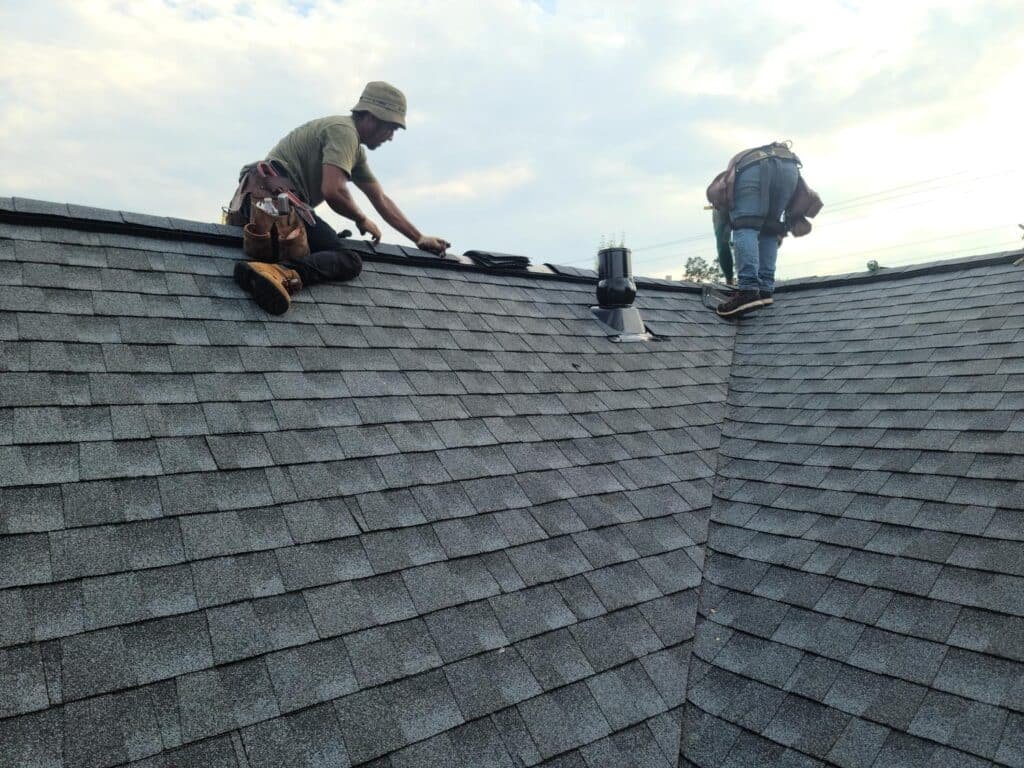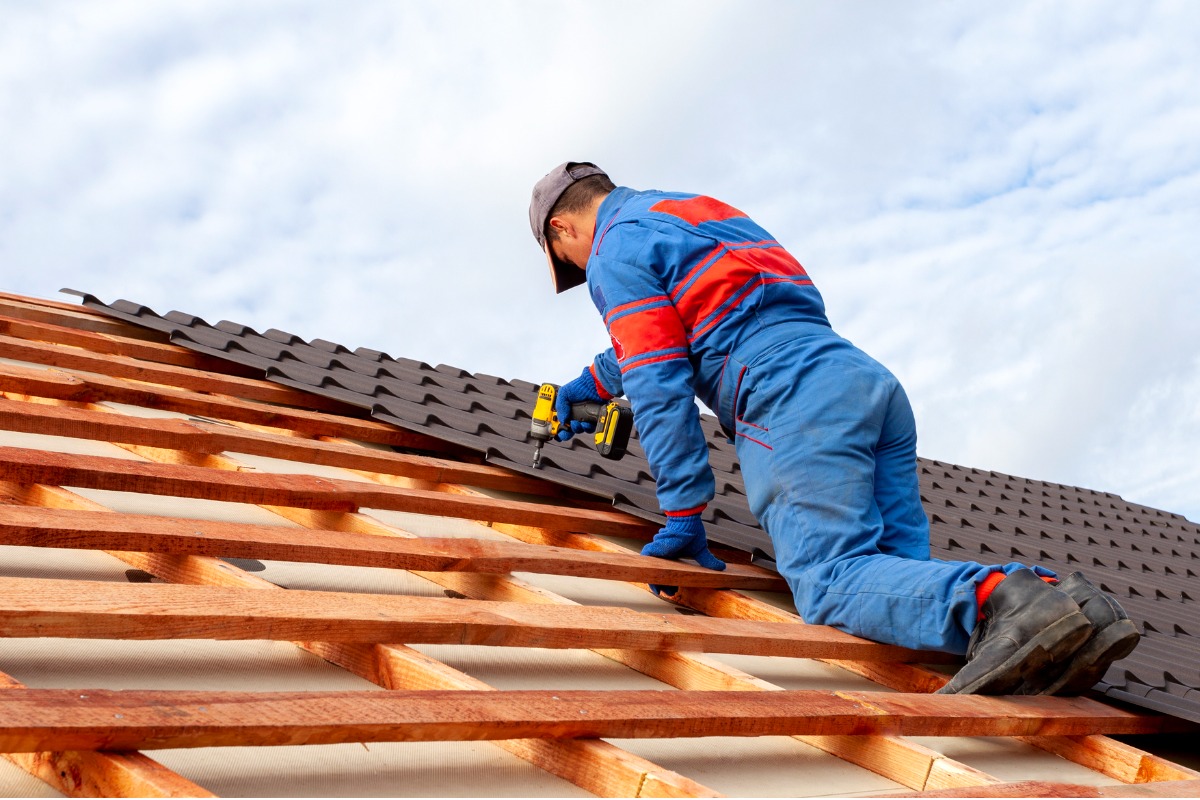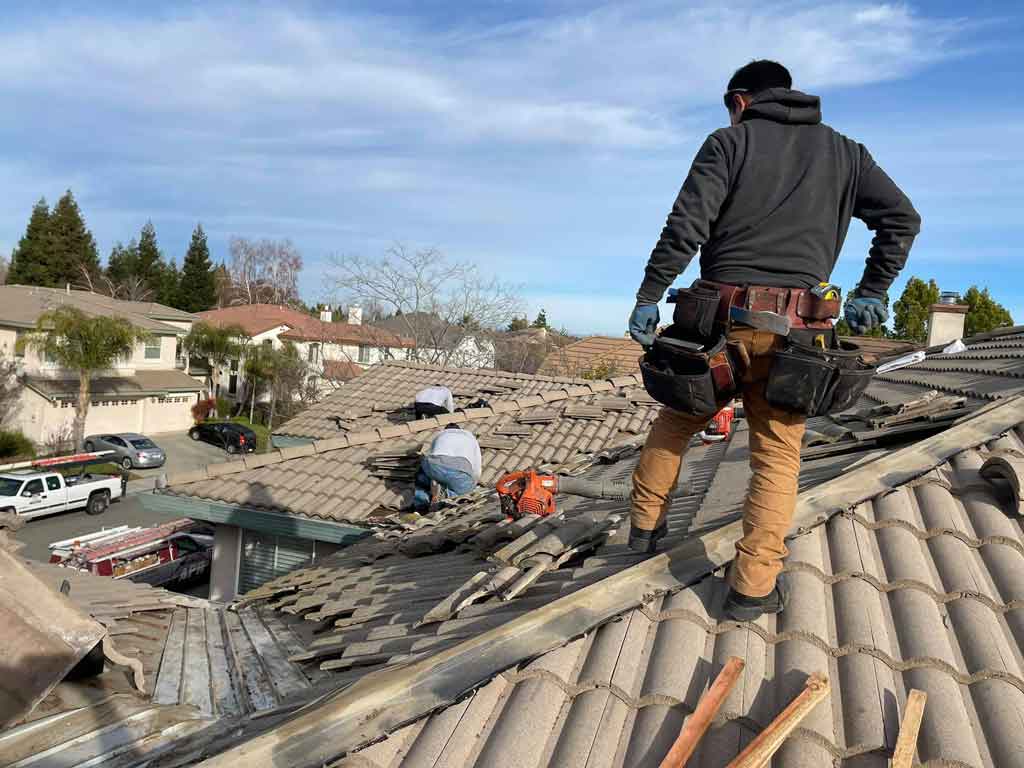Indications You Need Roofing System Repair Work: Shield Your Investment With These Easy Checks
Recognizing the indications that suggest a requirement for roofing repair work is crucial for protecting your building and financial investment. Typical indications such as missing out on shingles, unexpected water discolorations, and granules gathering in seamless gutters can recommend underlying issues that, if left unaddressed, might rise right into more serious troubles. Furthermore, indicators like sagging locations or boosted energy costs can also aim to inefficiencies or damages. To guarantee your roofing system remains in leading condition and to stay clear of expensive repair services, it is vital to identify these early warning signs and act as necessary. What steps should you take following?
Missing or Harmed Roof Shingles
When reviewing the condition of your roofing system, among one of the most telling signs of potential concerns is the existence of missing or harmed shingles. Tiles work as the initial line of defense versus the elements, and their stability is important for keeping the general health of your roofing system - St Louis Roofing Companies. A couple of missing shingles may appear minor, yet they can result in considerable water infiltration, endangering the underlying structure and requiring more extensive repair work
Harmed tiles can materialize in various methods, consisting of curling, breaking, or blistering. Each of these problems can minimize the performance of your roofing system, enabling dampness to pass through and cause extra severe troubles. Roofing Service. It is vital to perform regular evaluations, particularly after extreme climate occasions, as high winds and heavy rainfall can aggravate tile wear and tear
If you identify missing or damaged shingles, it is recommended to deal with these concerns immediately. While small fixings may be convenient for a house owner, substantial damages commonly calls for specialist treatment. Prompt action can stop additional issues and safeguard your investment, guaranteeing the longevity and performance of your roofing system.
Water Spots on Ceilings
Water stains on ceilings are usually clear signs of underlying water damages that requires prompt focus. Identifying the resource of these stains is necessary, as they can arise from various problems, consisting of roof covering leaks or pipes troubles. Addressing the origin not just stops more damages but also safeguards the honesty of the home.
Recognizing Water Damages

When examining for water stains, take note of both the dimension and form of the discoloration. Irregular forms might recommend ongoing leakages, while much more defined locations could show previous concerns. Additionally, think about the location of the stains; stains near plumbing components or outside wall surfaces may give hints concerning prospective sources of the water intrusion.
It is additionally vital to analyze the appearance of the ceiling bordering the discolorations. Peeling off paint or bubbling drywall can indicate extensive dampness exposure, requiring immediate attention. Regular evaluations and punctual activity can assist stop much more serious water damage, safeguarding both the architectural honesty of the home and the investment it represents. Always get in touch with a professional for a detailed evaluation if you uncover water discolorations on your ceilings.
Root causes of Spots
What aspects contribute to the look of stains on ceilings? Water discolorations, usually showing up as blemished spots, are mostly brought on by leaks in the roofing system or pipes systems - I&E Roofing & Construction, Inc.. When wetness penetrates through roof products or jeopardized plumbing, it can build up and result in visible staining on ceilings
One usual cause is harmed or missing out on roof shingles, which can enable rain to permeate into the attic and, at some point, to the ceilings below. In addition, incorrect blinking around smokeshafts, vents, or skylights can be a considerable source of water breach. Pipes leaks, whether from damaged pipes or overruning fixtures, can also produce stains, particularly in locations directly listed below washrooms or cooking areas.

Identifying the source of the tarnish is essential for effective repair work. Overlooking these indications can cause much more substantial damage, including mold growth and structural weakening, highlighting the value of prompt treatment to protect your investment.
Granules in Gutters
During regular inspections of your rain gutters, the visibility of granules can be a considerable sign of roofing system damage. These small, sand-like particles are commonly located externally of asphalt roof shingles, functioning as a safety layer versus UV rays and weathering. Gradually, deterioration can cause these granules to remove, leading to a series of problems that might compromise the honesty of your roofing system.
If you observe an accumulation of granules in your rain gutters, it is necessary to take this sign seriously. The loss of granules may reveal the underlying asphalt to the elements, increasing the danger of leaks and water damage. This circumstance not only jeopardizes your roofing's life expectancy but can also cause pricey repair work if not dealt with without delay.
To minimize possible damage, it is advisable to evaluate your roofing routinely, especially after serious weather condition occasions. Furthermore, involving a specialist roof covering service provider to assess the condition of your roof shingles can give valuable insights. Early treatment is vital to preserving your investment and making sure the longevity of your roof system. Keep in mind, granules in rain gutters are not a minor issue; they indicate the requirement for immediate attention and potential repair work.

Drooping Roofing System Locations
Sagging roof covering areas can suggest severe architectural concerns that need instant attention (Roofing Service). Visible deformities on the roofing system's surface, combined with the presence of water discolorations inside the home, are critical indication that must not be neglected. Dealing with these troubles without delay can prevent more damage and pricey repair services
Visible Roofing System Defects
Exactly how can property owners identify potential problems with their roofs? One of one of the most telling indicators is noticeable roof covering defects, especially sagging locations. A sagging roofing system may show up as dips or curves, indicating underlying architectural problems that can compromise the integrity of the whole roof system. Home owners ought to conduct regular examinations, searching for any obvious abnormalities in the roofline.
Several elements can add to noticeable defects, including water damages, incorrect setup, or the weight of gathered snow and debris. If a roofing shows up to droop, it may be an indication of damaged rafters or trusses, which can bring about a lot more serious problems if left unaddressed. A sagging roof covering not only jeopardizes the structural stability of the home yet can also lead to expensive fixing bills if the trouble rises.
If drooping or various other noticeable defects are observed, it is a good idea to speak with an expert roofer. They can analyze the scenario, figure out the source of the sagging, and recommend ideal fixing remedies. Timely intervention is crucial to shield your investment and guarantee the durability of your roofing.

Water Discolorations Inside Home
The visibility of water spots inside the home often signals possible problems with the roofing system, especially in locations where sagging has actually been observed. These discolorations normally suggest that water is penetrating through the roof product, which can result in substantial architectural damages if left unaddressed. Sagging roof covering areas may be triggered by a variety of aspects, consisting of poor support, collected wetness, or the wear and tear of roofing materials.
When you discover water stains, it is important to investigate the source of the wetness. Seek signs of sagging in the roofing framework, as this can exacerbate the problem. Usually, sagging locations can trap water, resulting in leakages and more damages. Additionally, it is important to review the age of the roof covering; older roofs are a lot more susceptible to damage, raising the likelihood of leaks.
Motivate activity is essential to reduce damages. Speak with a qualified roof covering expert to assess the circumstance and recommend appropriate fixings. Overlooking water spots and drooping can bring about pricey repairs and compromise the stability of your home. Shield your investment by dealing with these indicators before they intensify into more serious problems.
Increased Power Expenses
An unforeseen spike in energy expenses can usually signify underlying concerns with your roof. When your roof is endangered, it can result in significant air leakages, enabling conditioned air to leave and unconditioned air to infiltrate your home. This inefficiency pressures your heating and cooling down systems to function harder, resulting in raised power intake and higher utility expenses.
One typical culprit is harmed or missing out on roof shingles, which can subject your home's interior to the aspects. Additionally, insufficient insulation as a result of roof damages can contribute to power loss. If you notice a regular rise in your power costs without a matching adjustment in usage practices, it is vital to explore potential roof-related issues.
Normal roofing assessments are crucial for identifying problems prior to they intensify right into pricey repair work. Try to find noticeable signs of wear, such as drooping areas, cracks, or voids. These might indicate that your roof is no much longer providing the needed barrier against the aspects. Resolving these issues promptly can assist recover your home's energy performance and secure your financial investment in the long run. If you presume a problem, get in touch with a roof professional for a complete assessment.
Mold or Mildew Growth
Mold or mildew growth on your ceiling or wall surfaces can be a clear indication of roof-related issues, specifically when wetness infiltrates your home. These fungis flourish in moist environments and can position severe health and wellness threats, consisting of respiratory system troubles and sensitive responses. Their presence frequently suggests that your roofing system may be jeopardized, allowing water to seep in through leaks or voids.
To assess the situation, look for dark places or staining on surface areas, typically in areas near the roofline or where water might collect (I&E Roofing & Construction, Inc.). Furthermore, look for any kind of water stains, peeling paint, or soft areas in your ceiling or walls, which may show ongoing moisture troubles
If you observe mold and mildew or mold, it is vital to act quickly. Not only can continued wetness damages your home's architectural stability, yet it can additionally bring about pricey fixings down the line. Involving a professional roofer can assist identify the source of the issue, whether it's damaged roof shingles, incorrect ventilation, or various other concerns. Normal inspections and upkeep can assist avoid mold growth and secure your financial investment, making certain a secure and healthy living environment.
Age of the Roofing system
Evaluating the age of your roof covering is essential in determining its total problem and possible need for repairs. The majority of roof materials have a certain life expectancy, usually ranging from 15 to three decades, depending on the kind of material made use of. Asphalt roof shingles, for example, normally last about twenty years, while metal roof coverings can withstand for 40 years or even more. As roofing systems age, they come to be more vulnerable to damage from weather, parasites, and various other ecological aspects.
Regular examinations are essential for roofs older than 15 years. Indications of wear, such as cracked or curling tiles, missing floor tiles, or corrosion on metal surface areas, suggest that your roof covering may need prompt interest. Furthermore, internal signs like water spots on ceilings or walls can indicate underlying concerns linked to an aging roof covering.
If your roofing system is approaching its anticipated lifespan, take into consideration seeking advice from a specialist roofer for a detailed assessment. They can offer understandings on fixing alternatives or recommend a replacement if required. Aggressive monitoring of an aging roof can prevent costly damage to your home and guarantee that your investment stays protected.
Often Asked Inquiries
Just how Typically Should I Examine My Roof Covering for Damages?
Normal roof covering inspections are necessary for maintaining the honesty of your home. It is a good idea to inspect your roofing a minimum of two times a year, preferably in the spring and autumn, to recognize any prospective problems early on. Furthermore, after extreme climate occasions, such as heavy tornados or hail storm, a thorough examination is advised. Attending to minor damages immediately can protect against expensive repair work and extend the life-span of your roof covering system substantially.
Can I Repair My Roof Myself?
While it is feasible to repair your roof yourself, it is vital to examine your abilities and the intricacy of the damages. Minor issues, such as replacing a couple of shingles, might be manageable for a do it yourself enthusiast. Nonetheless, substantial repair services or structural concerns usually need specialist experience to guarantee safety and security and conformity with building ordinance. Always prioritize your safety and security and think about getting in touch with a roofing expert for comprehensive damages or if you doubt concerning the repair work.
What Are the Typical Reasons For Roof Leaks?
Usual Inc. causes of roofing system leaks consist of harmed shingles, which can take place because of age or extreme climate, and incorrectly sealed vents or flashing that may enable water infiltration. Additionally, blocked rain gutters can bring about water back-up, resulting in leaks. Structural problems, such as drooping roofs or jeopardized underlayment, likewise contribute to this problem. Routine assessments and upkeep are necessary to identify these vulnerabilities and protect against pricey damages to your home.
Just How Can I Pick a Reputable Roofer?
Choosing a reputable roofer includes extensive research and assessment. Beginning by looking for suggestions from trusted resources and inspecting on the internet evaluations. Verify the contractor's licensing, insurance, and experience in roof jobs similar to your own. Demand thorough price quotes and compare them for transparency. Additionally, ask about service warranties and post-installation assistance. A reliable contractor needs to connect plainly and demonstrate professionalism and reliability throughout the process, guaranteeing your investment is well shielded.
What Is the Typical Lifespan of Various Roof Products?
The typical life-span of roof materials varies substantially. Asphalt roof shingles usually last 15 to 30 years, while steel roofing systems can sustain 40 to 70 years. Wood drinks typically have a lifespan of 20 to 40 years, whereas clay or concrete floor tiles can surpass half a century with appropriate upkeep. Synthetic roof covering materials might use longevity equivalent to standard alternatives, typically long-term 30 to 50 years. Comprehending these life-spans help in preparing for upkeep and substitute.